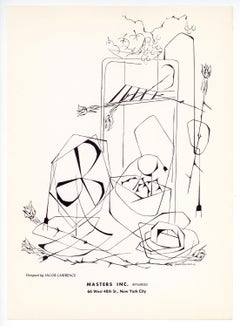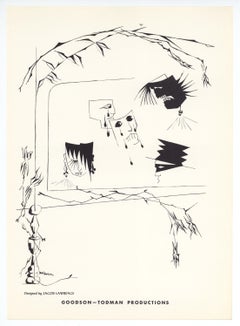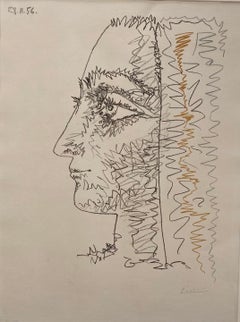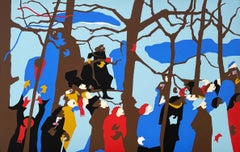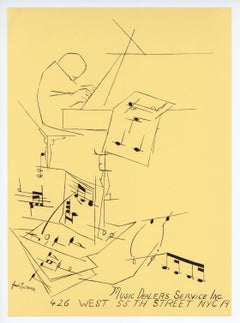Jacob Lawrence Art
One of the first Black artists to receive national acclaim in the United States, Jacob Armstead Lawrence (1917–2000) was born in Atlantic City, New Jersey, before moving to Philadelphia, Pennsylvania, and then to Harlem, New York, in 1930. While enrolled in a community after-school arts program, Lawrence developed his talents as a painter, drawing praise and encouragement from artist Charles Alston, who ran the program at the time. Despite his family’s financial struggles during the Great Depression, Lawrence continued his pursuit of the arts, developing a series of multipanel realist paintings dedicated to iconic Black historical figures, including Toussaint L’Ouverture, Frederick Douglass and Harriet Tubman. In 1938, he had his first solo exhibition at the Harlem YMCA and had begun to work for the Works Progress Administration (WPA).
In 1940, Lawrence received a grant from a philanthropic organization called the Rosenwald Fund, which allowed him to begin what would become his most famous work: The Migration Series, a narrative piece comprised of casein tempera paint on 60 18-by-12-inch hardboard panels featuring captions he’d written before he began to paint. (Fellow artist and future wife Gwendolyn Knight helped with the text.) Lawrence’s series focuses on the Great Migration of Black Americans from the agricultural South to the industrial North between 1910 and 1940.
By the end of the 1940s, Lawrence had earned widespread recognition for his important work and was the most celebrated Black artist in the United States. He continued covering Black historical figures throughout his career, though he also painted social commentaries on contemporary issues, like World War II and civil rights. He taught at the Art Students League in New York and at Black Mountain College in North Carolina (upon invitation from artist Josef Albers), among other institutions.
Lawrence’s works can be found in the collections of many major museums, including the Museum of Modern Art, the Metropolitan Museum of Art and the Whitney Museum of American Art in New York and elsewhere. His painting The Builders hangs in the White House today, as it was acquired by the White House Historical Association in 2007.
Find watercolor paintings, prints and more by Jacob Lawrence on 1stDibs.
1980s Contemporary Jacob Lawrence Art
Offset
1950s Jacob Lawrence Art
Lithograph
1950s Jacob Lawrence Art
Lithograph
1990s American Modern Jacob Lawrence Art
Screen
1950s Jacob Lawrence Art
Lithograph
1970s Modern Jacob Lawrence Art
Lithograph
1970s Modern Jacob Lawrence Art
Gouache
1970s Abstract Expressionist Jacob Lawrence Art
Lithograph
1980s Modern Jacob Lawrence Art
Color, Screen
1970s Modern Jacob Lawrence Art
Archival Pigment
1970s American Modern Jacob Lawrence Art
Screen, Paper
1990s Contemporary Jacob Lawrence Art
Screen
Mid-20th Century American Modern Jacob Lawrence Art
Drypoint, Etching
1950s Modern Jacob Lawrence Art
Lithograph
1980s Modern Jacob Lawrence Art
Offset, Lithograph
20th Century Modern Jacob Lawrence Art
Lithograph
1940s American Realist Jacob Lawrence Art
Offset
1950s Modern Jacob Lawrence Art
Lithograph
21st Century and Contemporary American Modern Jacob Lawrence Art
Archival Ink, Archival Pigment
1960s Modern Jacob Lawrence Art
Lithograph
1990s American Modern Jacob Lawrence Art
Screen
1980s American Modern Jacob Lawrence Art
Screen
20th Century Modern Jacob Lawrence Art
Lithograph
1960s Abstract Jacob Lawrence Art
Lithograph
1970s Pop Art Jacob Lawrence Art
Screen
1950s Jacob Lawrence Art
Lithograph
1970s Jacob Lawrence Art
Paper, Lithograph
20th Century Post-Impressionist Jacob Lawrence Art
Board, Tempera
1990s Contemporary Jacob Lawrence Art
Screen
1970s American Modern Jacob Lawrence Art
Screen
1990s Contemporary Jacob Lawrence Art
Screen
1970s Modern Jacob Lawrence Art
Lithograph
1970s Modern Jacob Lawrence Art
Lithograph
1970s Modern Jacob Lawrence Art
Lithograph
1970s Modern Jacob Lawrence Art
Lithograph
1980s Contemporary Jacob Lawrence Art
Offset
Jacob Lawrence art for sale on 1stDibs.
Artists Similar to Jacob Lawrence
- 1stDibs ExpertMarch 22, 2022Dynamic cubism is the style that American artist Jacob Lawrence is known for. Lawrence coined the term himself to describe the repeated patterns and vivid colors that defined his works. To produce his paintings, he largely drew inspiration from Harlem, New York. Find a selection of Jacob Lawrence on 1stDibs.
- 1stDibs ExpertFebruary 1, 2024Jacob Lawrence was known for being one of the first Black artists to receive national acclaim in the United States. His narrative paintings include pieces on Black historical figures, World War II and civil rights. His most famous work — The Migration Series — focuses on the Great Migration of Black Americans from the agricultural South to the industrial North between 1910 and 1940. On 1stDibs, find a variety of Jacob Lawrence art.

